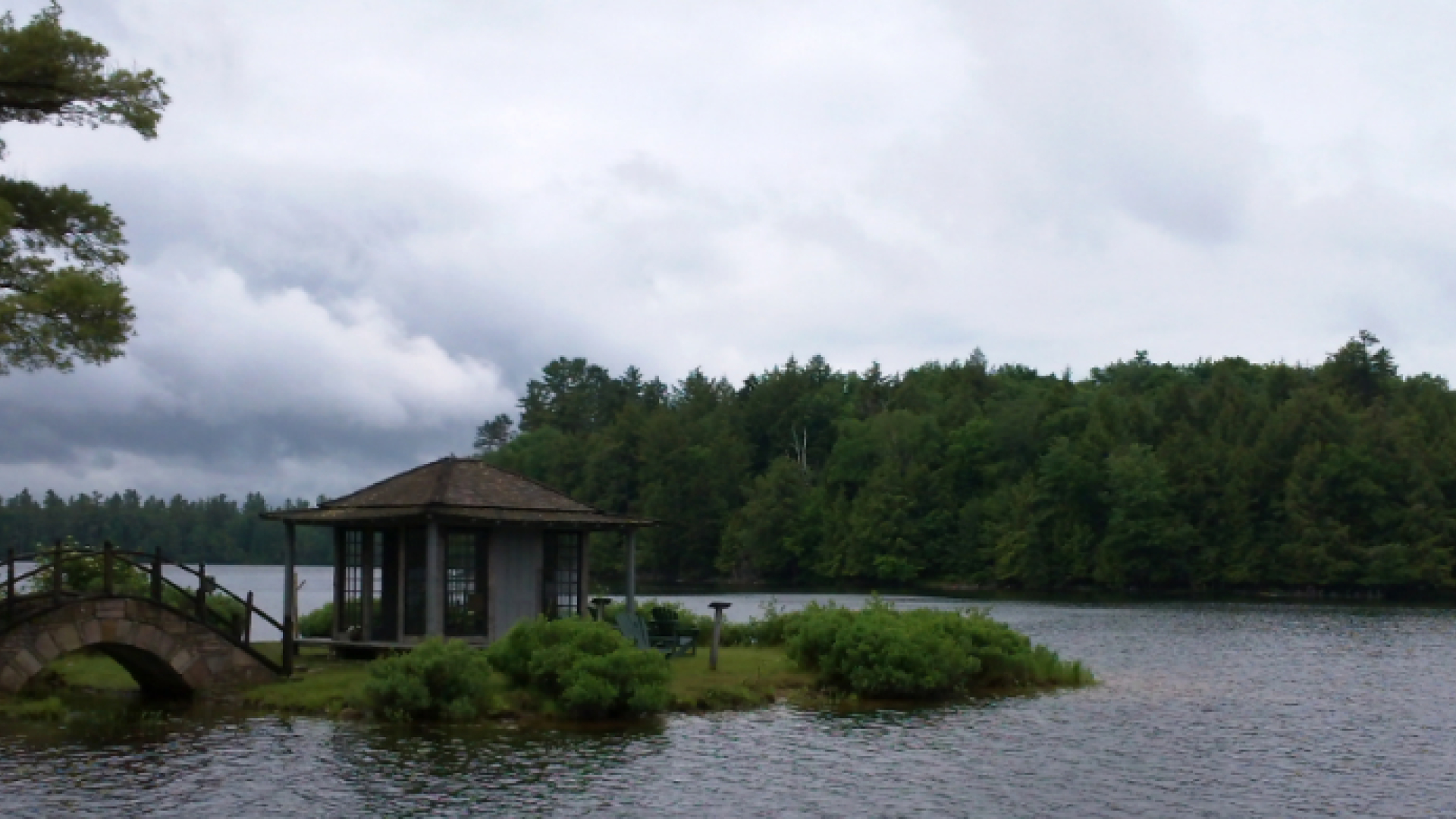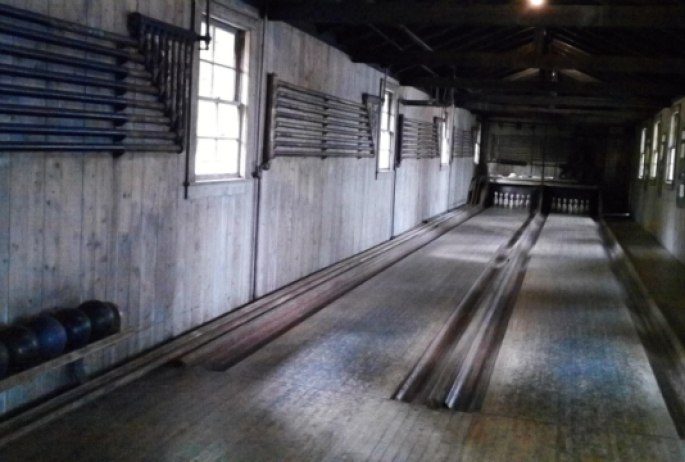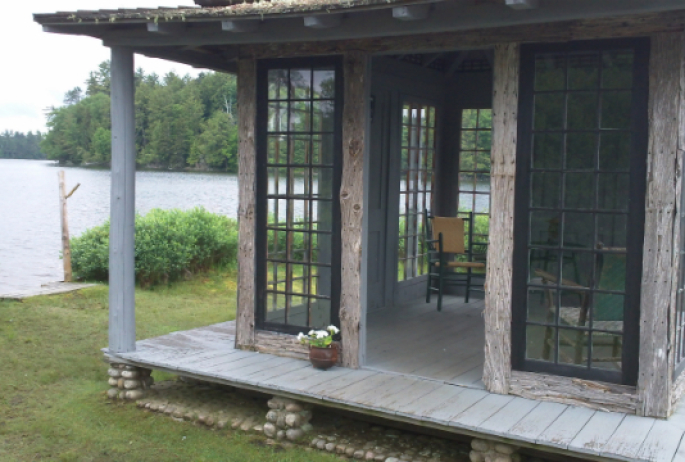The Saranac Lake area was once home to many Great Camps, the elaborate form of "roughing it" that the very rich enjoyed during the Gilded Age. Time has not been kind to this extravagant tradition. Because of the risk of fire, each room was designed as its own building, and because of their remote locations, many of them burned down, anyway. Between the deep winters and the wilderness itself, keeping them up became expensive and difficult, even for the great fortunes which had built them.
So we are fortunate to have a lovely example from 1911 still in operation. White Pine Camp is also open for tours. I attended the first of the season, which turned out to be an overcast day. It doesn't matter. Our tour guide meets us at the gate with extra umbrellas. A rainy day in the Adirondacks usually means a lot of mist and breaks in the weather, so a tour that goes indoors and outdoors, back and forth, is one that is made for such a day.
As every photographer knows, a bright overcast is perfect for picture taking.
Extraordinary Gardens
This shows up in our first stop, the Fred Heutte Alpine Rock Garden. White Pine Camp was known as the most extensively landscaped of all the Great Camps, and this garden is one of the features that made it unique. Decades of neglect had covered up all the rocks and trees with foot wide trunks had sprung up in the midst of the plantings. Recently restored to its 1920's glory, this delightful spot now offers a meditative oasis amidst the forest.

We move on down the lane, once lined with flowers, and even a portable bar. The lady of the camp, Olive Moore White, was a prominent socialite (and former light opera singer) who famously declared she did not want to walk more than 300 feet to get a drink. Patches of flowers gone wild, like Japanese iris and batchelor's buttons, still spring up this time of year, beautifully outlined among the white birches, though the bar is now gone.
Such pampering was not unusual in the Great Camps, with their high servant-to-guest ratios. Between servants brought from New York City and local guides, cooks, and housemaids, many of the buildings, and even sections of the guest cabins, were devoted to housing the help. There was an onsite laundress and seamstress to keep guests' clothes looking good, a group of guides ready to take someone hunting or fishing, and plenty of bartenders.

From early July through mid September of 1926, President Calvin Coolidge and First Lady Grace Coolidge were in residence, with visits from heads of state, ambassadors, prominent commerce figures, and White House Staff, including then Secretary of Commerce Herbert Hoover. A special boathouse was built to accommodate the overflow and offer another area for launching canoes and enjoying Osgood Pond. The press loved to visit and snap photos of the President, not known to be an outdoorsman, trying his hand at angling.
fear of a dull moment
It would seem that a Great Camp's host & hostess' greatest fear was that, once lured out into their wilderness, their guests would wind up bored. To ensure such a terrible event would not occur, the bowling alley was part of the camp's original plans. This was not an unusual addition to a fine mansion, especially in the late 1800's.
This game room features the original rack which lets the pins be set up properly, and even a ball return system which our guide was happy to demonstrate. My own bowling, due to the 100 year old lane, was only so-so. This game room also had a a large stone fireplace for chilly evenings, a pool table (though not the original,) and a tiled back porch angled to catch the sunset over Osgood Pond.

But the most spectacular building in this collection is the famous Tea House. Once the Goulds and Vanderbilts had tea houses built on their estates, no one could pass up their own chance to sip and shine. The highest conventions of the form called for it to be placed on its own island, accessible by bridge, so Mr. White was somewhat fortunate that a prominent point was able to be dredged across to become his wife's island.
It is a most charming little building, with walls of glass framed in metal, and to reach it by the beautiful stone bridge is to feel transported to another world and time. This was a popular ladies' spot, while the Hermit's Hut, (the most remote building on the property,) was for the bachelors.

Ghost of Greatness
All Great Camps had a Great Room. Sadly, the original burned down mid-20th century, though valiant efforts by Paul Smiths' college students saved the other buildings. While the new Great Room keeps the original style elements and some of the furniture, it is a scaled down version from the grand expanse which featured a giant couch hanging on chains, an imposing marble fireplace, soaring cathedral ceiling, and two stages where guests put on shows for each other. Olive Moore White made friends wherever she went, and many of them were in show business.
As seen now, outbuildings and outdoor furniture trace the outlines of what this room once had been. It is reached by rustic stairs built into the side of the hill, climbing up from the shore with the tea house and original boathouse, and there are spectacular views through the trees.
It takes actually exploring the whole complex to grasp the amazing sweep of the grounds and the buildings. Because there are so many, and they are nestled into the trees with cunning roof angles and simple materials, it is easy to overlook how much festivity, and famous people, must have been accommodated there at the height of its popularity. While the President's visit led to the nickname "Summer White House," it was far from the only identity of White Pine Camp.
This is where a 46 pound cherry pie was delivered to President Coolidge, a gift from the Grand Traverse Cherry Growers of Michigan. This is where the local populace would row out onto the pond to hear Enrico Caruso sing his morning opera exercises. This is where, in 1914, Count Johann Heinrich von Bernstorff, German Ambassador, became engulfed in a scandal that dashed the hopes of Germany for a lucrative business deal with the US, a turn of events that might have affected the outcome of World War I.

It was a very different time, one hundred years ago, when being outnumbered by servants was commonplace at these elaborate rustic mansions. A time before air conditioning, when "vacating" New York City to escape the heat and crowds and health hazards was sought after by both rich and poor. When the trip up was so long and involved that guests were expected to stay a minimum of two weeks, and a visit which stretched over the whole summer was not unusual.
But one thing has not changed a bit. That is the longing for cool green forests, the lap of lake water, the stretch of blue sky above the treetops. The Adirondacks are still here to give visitors as much, or as little, wilderness as they desire. As a spot "Forever Wild" we hope to do so for many generations to come.
While the tours last two hours, there's still plenty of exploration to be found in Paul Smiths, the town named after the famous Adirondack Guide. Hike at the Visitor Interpretive Center with its many wonderful paths, butterfly house, and scenic decks. Paddle the Jones Pond to Osgood Pond connection for a fresh perspective. And you are still not far from Saranac Lake where a fine meal awaits.












